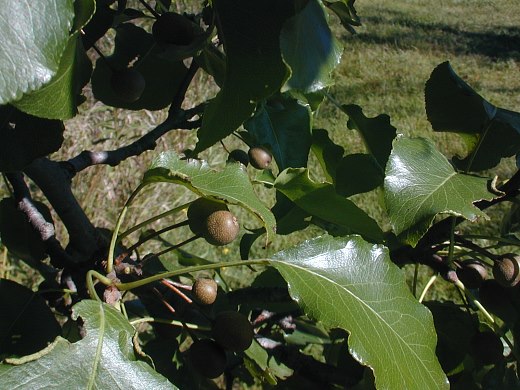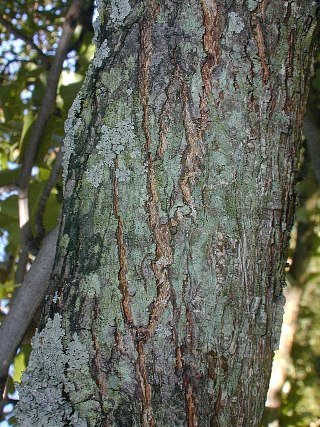Description: This small to medium-sized tree is 20-50' tall with multiple ascending branches; the crown is usually longer than it is wide. The gray bark of the central trunk has shallow furrows and flat scaly ridges; it is often partially covered with lichens. The bark of smaller branches and twigs is greyish or reddish brown and smooth with small lenticels. The terminal buds of the twigs are rather large (about ½" long) and usually pubescent; sometimes thorny spur shoots are present. The blades of the alternate leaves are 2-3" long and about half as much across; they are ovate with margins that are finely serrate or crenate. The upper surfaces of the blades are dark green, hairless, and shiny; their lower surfaces are pale green and dull. The petioles of the leaves are 1-2" long, light green, and slender.

During the mid-spring, clusters of several white flowers develop from the axils of young leaves; these flowers often appear shortly before the leaves develop. The pedicels of the flowers are slender and ascending to slightly drooping. Each flower is ½–¾" across, consisting of 5 white petals, a light green calyx with 5 teeth, 15-20 stamens, and 2-3 styles. Each fertilized flower produces a single globoid fruit (a pome) about 1/3–1/2" (8-12 mm.) across. The exterior of a mature fruit is light brown with pale dots, while its fleshy interior contains about 2 seeds. Usually, the flavor of the fruit is bitter. On mature fruit, the teeth of the calyx are usually deciduous. Fall color of the leaves is variable as this depends on the cultivar.
Cultivation: This tree adapts to full or partial sun, moist to dry-mesic conditions, and soil containing loam, clay-loam, or sandy loam. The pH of the soil can be acidic to alkaline. Winter cold is tolerated to Zone 5. The Callery Pear is fast-growing, but rather short-lived (30-50 years); its branches are prone to ice and storm damage.
Range & Habitat: According to the currently available map, the Callery Pear has naturalized only in DuPage and Champaign counties in Illinois (see Distribution Map). However, more recently it was discovered that this introduced tree has spread rapidly to 66 counties all over Illinois (White et al., 2005). It seems likely that this species will continue to spread throughout state as the wild trees produce abundant fruits with fertile seeds. So far, the Callery Pear has been found in various disturbed habitats, including degraded open woodlands, woodland borders, thickets, fence rows, and fallow fields. This habitat information has been compiled from several states in the eastern half of the United States, where the Callery Pear has also naturalized. This tree is widely cultivated as an ornamental landscape plant and about 20 cultivars are available. While some cultivars are self-sterile, cross-pollination across cultivars can produce trees with fruit that contain fertile seeds. The Callery Pear is native to East Asia.

Faunal Associations: The nectar and pollen of the flowers have been found to attract honey bees, bumblebees, cuckoo bees (Nomada spp.), mason bees (Osmia spp.), a large carpenter bee (Xylocopa virginica), a small carpenter bee (Ceratina calcarata), a leaf-cutting bee (Megachile sp.), Andrenid bees (Andrena spp.), Halictid bees (Augochlora pura, Halictus sp.), Syrphid flies (Helophilus fasciatus & others), a Tachinid fly (Epalpus signifer), and a paper wasp (Polistes annularis); see Steury et al. (2009) and Dolan et al. (2023). Little is know about insects that feed destructively on Callery Pear in North America as this tree seems to resist most pests. A minor exception is the Eastern Tent Caterpillar (Malacosoma americanum), which will feed on this tree when its preferred host plants, like cherry trees (Prunus spp.) and crabapple trees (Malus spp.), are not readily available (Hartshorn et al., 2022). Among vertebrate animals, such birds as the Cedar Waxwing, European Starling, and American Robin, have been observed to feed on the fruits (Wilhelm & Rericha, 2017). By dispersing the seeds of the fruits, these birds help to spread this aggressive tree to new locations. Elk reportedly browse on the leaves and twigs of Callery Pear to some extent (Schneider et al., 2006).
Photographic Location: A thicket at Lake-of-the-Woods in Champaign County, Illinois. The photographed tree is a naturalized specimen of the Callery Pear.
Comments: While the Callery Pear is an attractive landscape tree, it is spreading rapidly as a naturalized tree, where it may become as much of a pest as such trees as the White Mulberry (Morus alba), Autumn Olive (Elaeagnus umbellata), and Common Buckthorn (Rhamnus cathartica). Another common name of Pyrus calleryana is 'Bradford Pear,' but this more properly refers to a widely planted cultivar of this species. The other pear species that naturalizes uncommonly in Illinois is the Cultivated Pear (Pyrus communis), of which there are also many cultivars. This latter species can be readily identified by its large pyriform fruits that become yellow to red when they are ripe. One popular cultivar of the Cultivated Pear is called the 'Bartlett Pear,' which is cultivated for its large edible fruit. In contrast, the Callery Pear produces small spheroid fruits that become brown when they are ripe.